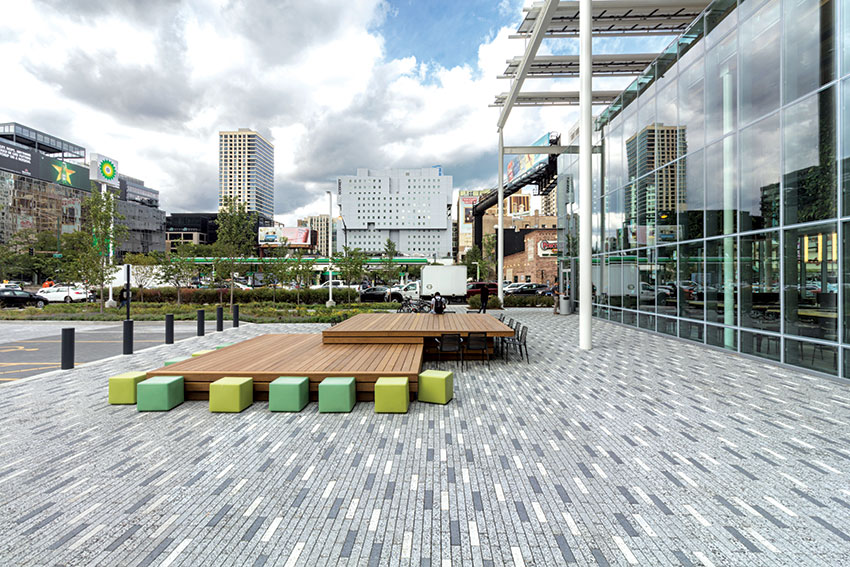The Climate-Positive Benefits of Concrete in Outdoor Architecture
Pavers vs. Poured-in-Place
To give this more context, consider the mass value of concrete used in a hypothetical project, comparing poured-in-place (PIP) to precast pavers. Pavers offer the opportunity to save up to 60 percent of the mass of concrete volume. This is entirely dependent on the design.
In a reference project, 150mm thick PIP concrete was specified for pedestrian spaces, with a 60mm precast paver specified for the same application. As 60mm is 40 percent of 150mm, the savings is 60 percent of the mass. Now the strength of the concrete also dramatically influences the embodied carbon value. The higher the strength, the higher the value because more cement is required. Pavers are always made to meet and exceed 8000 psi, while PIP can be as low as 3000 psi. When the embodied carbon value for the material selection is correlated, there is an opportunity to reduce the embodied carbon by at least 25 percent when using precast pavers rather than PIP, with exact calculations dependent on an actual project.
Engineered Walls and Segmental Retaining Walls
When considering retaining walls, comparing cast-in-place to segmental retaining walls (SRW), the environmental consequences are design-dependent. The material volume may be about the same in some cases, whereas other designs may see a significant advantage for segmental retaining walls. A report from Brazil titled “Comparative study of retaining walls aiming to optimize carbon footprint”8 compared reinforced concrete cantilever walls to mechanically stabilized earth (MSE) with a geogrid-reinforced SRW. The CO2 emissions of the SRW were 75 percent less than PIP walls. Add to that the end-of-life scenario and the ability for SRW to be reused and reconfigured; there is a definite advantage for SRWs.
Each site needs careful evaluation for every engineered application to determine the best practice. This will depend on the soil conditions, the allowable space for the system, the aesthetic finish, and the project's environmental goals. Although it can seem counter-intuitive to use manufactured materials that seem to have a high carbon value, the amount of these materials used in the system (soils, grid, and SRW block and engineering input) can be substantially less than traditional ground engineering solutions. Additional consideration can be given to gravity-engineered walls as there is less disruption to native soils and required backfill.
THE IMPACT OF MATERIAL CHOICES IN OUTDOOR ARCHITECTURE
Materials matter in outdoor architecture, and each must be weighed against various criteria. A material with a low-carbon-emitting score that is short-lived and needs to be replaced often may not be the best choice. Here are factors to consider.
Tools to Measure Environmental Impact
As we grapple with the complex situation in which we find ourselves amid a climate crisis, new tools emerge to measure the environmental impact of materials. The Embodied Carbon in Construction Calculator (EC3) tool compares different suppliers of a specific material. Beacon and Tally look at the LCA for a whole building. Pathfinder and Carbon Conscience were developed explicitly for landscape projects and encompass a variety of material choices. Many more tools are available, and new programs are constantly coming online.
Environmental Product Declarations
At the center of all these tools is the Environmental Product Declaration (EPD) which calculates the embodied carbon value of products for the built environment. There are four types of EPDs: 1) Industry-wide, with the least specific data; 2) Product specific, which could be manufactured at multiple facilities; 3) Supply chain specific, which is a product-specific EPD that uses supply chain-specific data in the LCA to model impacts of key processes upstream, and 4) Facility-specific EPDs. EPDs are developed according to Product Category Rules (PCR) so that all products within the same category are created similarly. Lastly, they are verified by a third party. With this data, designers, and specifiers have context for choices.
Understanding and comparing various concrete products within their unique categories is important. Again, because compressive strength is important to the integrity and durability of a product such as a unit paver, it should not be compared to a cement product created in a concrete masonry unit (CMU) category. Ensure that the Product Category Rules, ISO, and ASTM standards align between the EPDs being compared.
Recycled or Recyclable Materials
The impact of product choices is not always apparent. There may be the option to use recycled steel or plastic materials, use reclaimed or sustainably harvested materials, or reduce some materials. It’s also important to understand how the project will be deconstructed at its life’s end and what can be recycled or reused.
Materials can be optimized. For instance, specifiers can use performance-based specs, allowing cement substitutes in the mix design to explore alternatives to poured-in-place materials. The process for any reuse or recycling will also need to be considered to estimate the carbon balance of the process or energy usage and type for the recycling process. And there may also be many new types or alternative methods that will evolve in the coming months or years.
Natural and Local Materials
Using native and resilient plants allows less need for transportation to the site and less maintenance or replacement over time. Likewise, specifying concrete products manufactured closest to the project also reduces carbon emissions. Ideally, the manufacturer of the preferred product maintains multiple plants around the country.
Durable and Long-Lived Materials
While a material might seem like a low-carbon choice, the initial calculations are skewed if that product is not resilient and often needs to be replaced or repaired. Materials durable enough to last decades will ultimately cause fewer emissions.
Maintenance Matters
Understanding the maintenance requirements of a project once it is built is critical for sustainability. This could lead to incorporating features to facilitate ease of maintenance. This could include onsite composting to shore up the soil beds created. Consideration should be given to avoiding fossil fuel-based fertilizers and powered lawn equipment.










